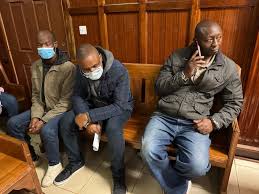The accused persons, Arthur Otula, Rosemary Daraja, Peter Abuna, Robert Ingasira, and Archprime Medical Clinic Oyugis Ltd appeared before a Nairobi court where they denied ten counts ranging from conspiracy to defraud, falsification of health information, acquisition and use of proceeds of crime, to uttering false documents and misappropriation of funds.
According to the charge sheet, the suspects, jointly with others not before the court, allegedly conspired between October 2024 and May 2025 to defraud SHA of Ksh. 17,591,473 by submitting falsified medical claims under Archprime Medical Clinic in Oyugis, Homa Bay County.
In the first count, the prosecution accused all six of conspiracy to defraud contrary to Section 317 of the Penal Code.
In the second count, Otula, Daraja, and Abuna were charged with falsification of health information contrary to Section 48(1)(c) of the Social Health Insurance Act, by knowingly falsifying medical documents to claim benefits not lawfully due.
The third and fourth counts accused Otula, Daraja, and Archprime Medical Clinic of acquiring and using proceeds of crime contrary to the Proceeds of Crime and Anti-Money Laundering Act, by obtaining and utilizing over Ksh.17 million in fraudulent SHA payments.
Rosemary Daraja, who served at Archprime Clinic, faced an additional five counts of uttering false documents contrary to Sections 353 and 349 of the Penal Code, for allegedly submitting falsified medical records of several patients — including Edna Amondi Dulo, Maureen Atieno, Alice Akinyi Oburu, Felix Omondi Omondi, and Andrew Okaka — to SHA while purporting them to be genuine.
In the final count, Elijah Wachira and Robert Ingasira, both officials of the Social Health Authority, were charged with misappropriation of funds contrary to Section 48(2) of the Social Health Insurance Act, for allegedly mishandling the Ksh17.5 million belonging to the Authority. All the accused pleaded not guilty to the charges and have been granted a cash bail of Ksh.500,000 each.






